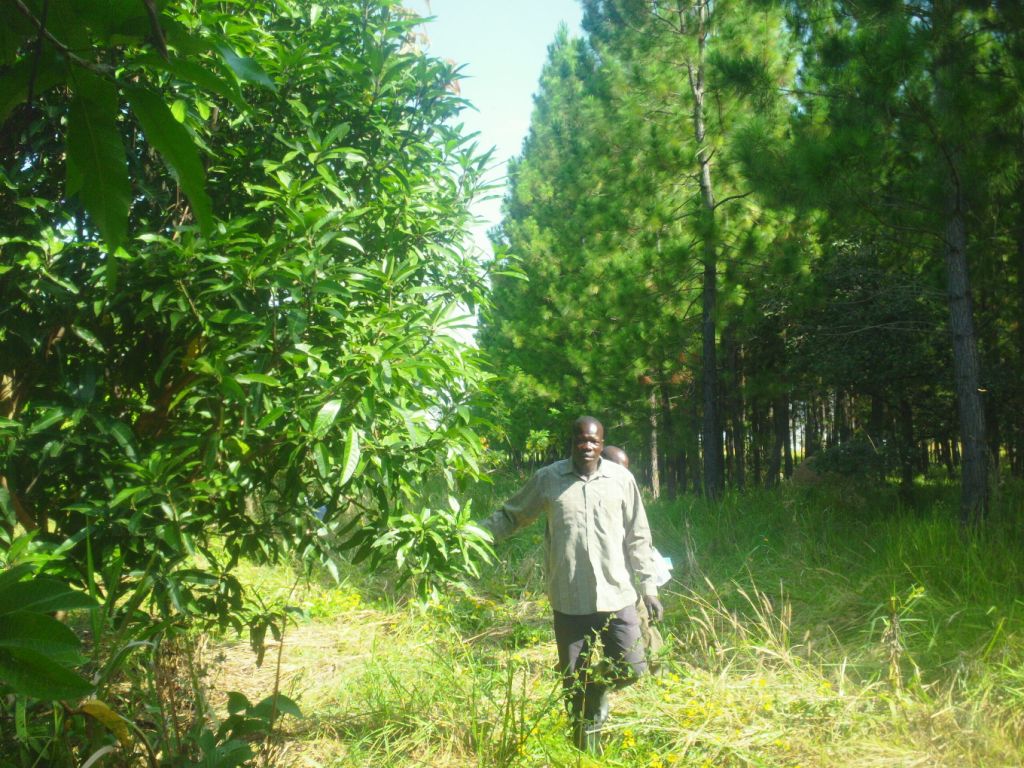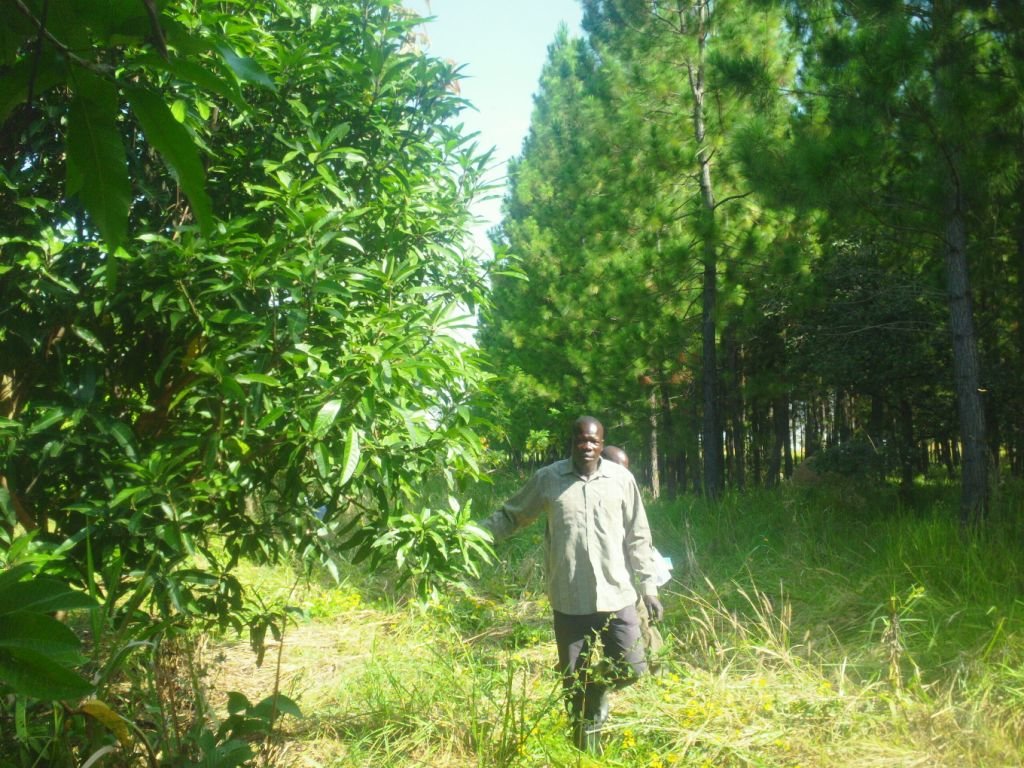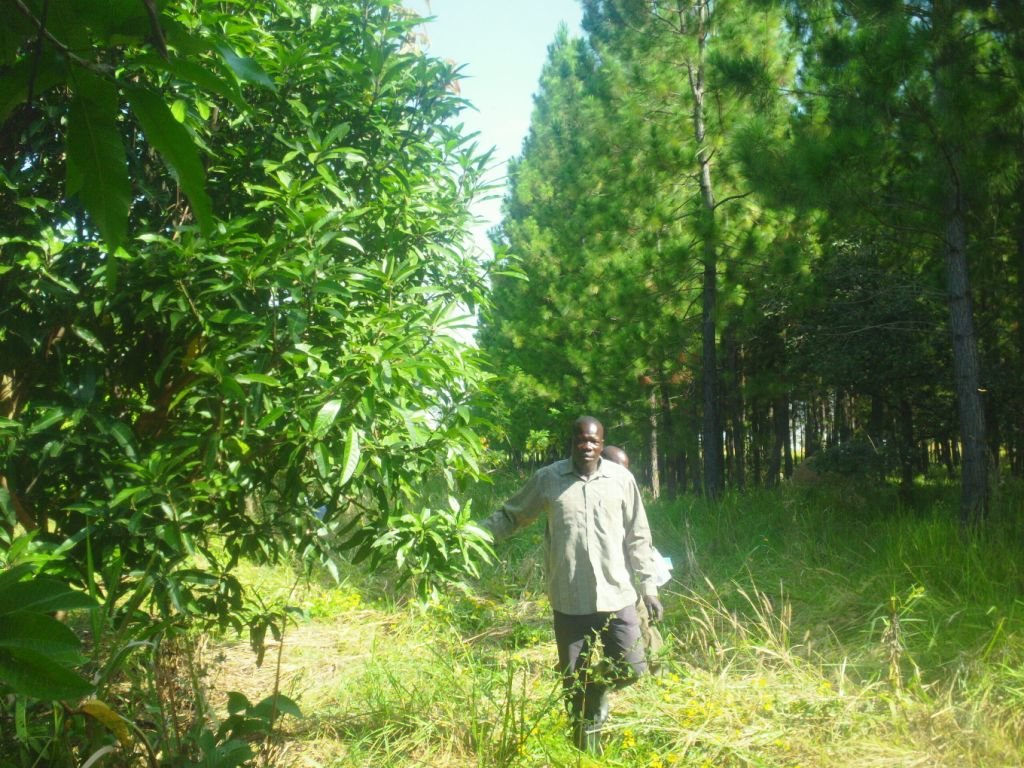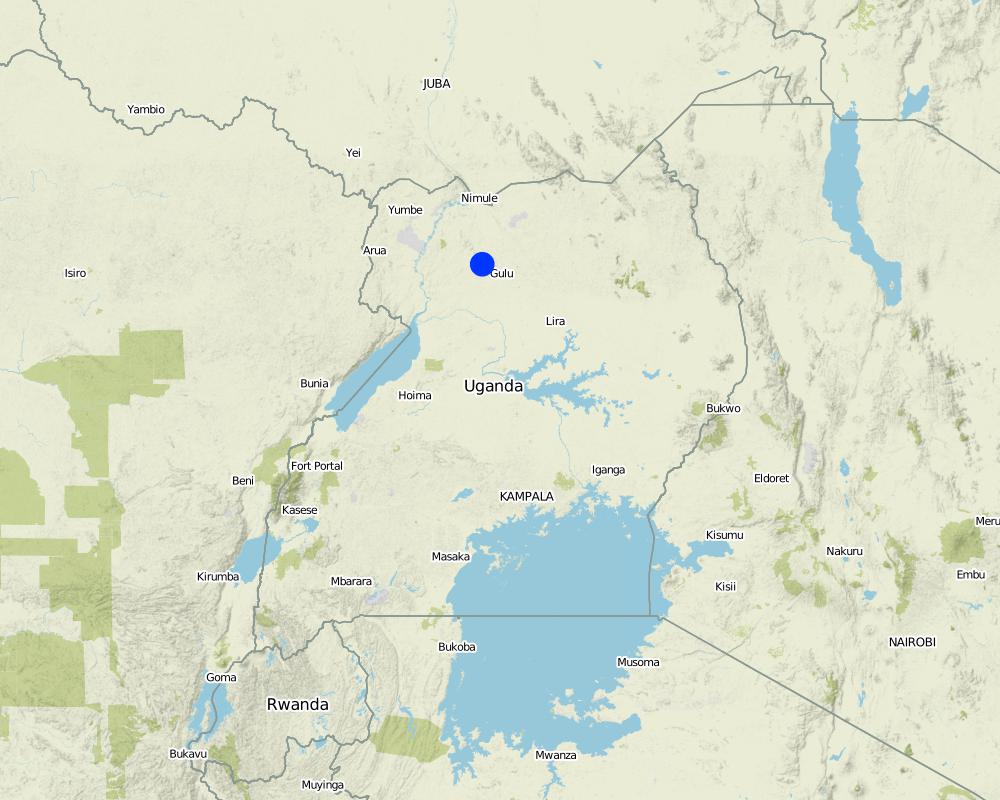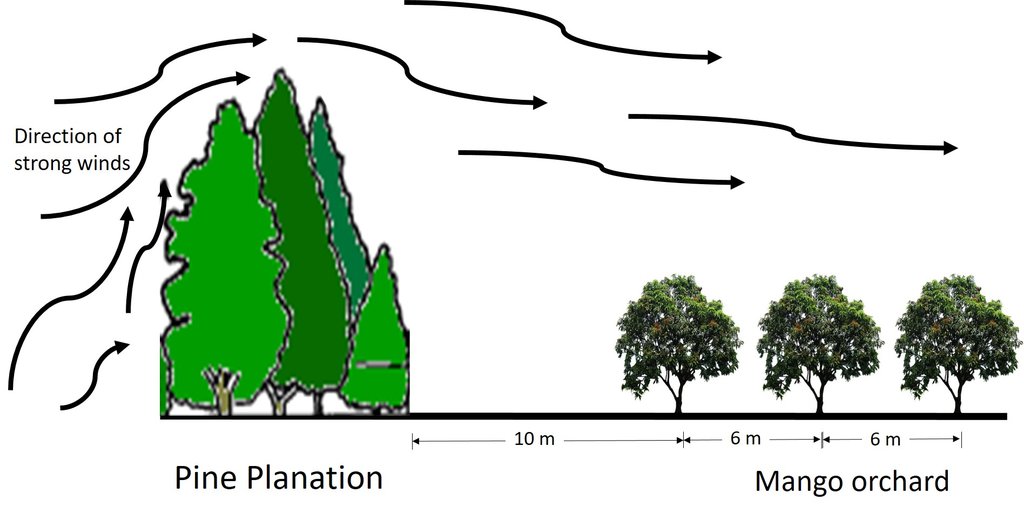Pine-shielded mango growing [乌干达]
- 创建:
- 更新:
- 编制者: Bernard Fungo
- 编辑者: JOY TUKAHIRWA, Kamugisha Rick Nelson, betty adoch, Sunday Balla Amale
- 审查者: Nicole Harari, Renate Fleiner
Pito yen PIne Inget mayembe
technologies_2880 - 乌干达
查看章节
全部展开 全部收起1. 一般信息
1.2 参与该技术评估和文件编制的资源人员和机构的联系方式
关键资源人
土地使用者:
Abok Robert
+256786841627
Amuru district Local Government
Amuru district
乌干达
有助于对技术进行记录/评估的项目名称(如相关)
Scaling-up SLM practices by smallholder farmers (IFAD)有助于对技术进行记录/评估的机构名称(如相关)
Uganda Landcare Network (ULN) - 乌干达1.3 关于使用通过WOCAT记录的数据的条件
(现场)数据是什么时候汇编的?:
11/05/2017
编制者和关键资源人员接受有关使用通过WOCAT记录数据的条件。:
是
1.4 所述技术的可持续性声明
这里所描述的技术在土地退化方面是否存在问题,导致无法被认为是一种可持续的土地管理技术?:
否
2. SLM技术的说明
2.1 技术简介
技术定义:
Pine-based shelter belt is used to protect an orchard of mangoes against strong winds in order to prevent abscission of generative organs such as flower buds, flowers, small fruits and ripened fruits
2.2 技术的详细说明
说明:
Falling of flower buds and young fruits are brought about by strong winds common in northern Uganda. This can significantly reduce the number of fruits harvested and therefore cause a reduction in income to the farmer.
Fruit trees (mainly mangoes and oranges) are protected from strong winds by establishing a pine plantation beside the orchard. The plantation of pine is established in the direction from where the strong winds come and the fruit trees are established on the opposite side so that the wind velocity is reduced by the pines before it damages the fruit trees. This is because pine trees generally grow taller than the fruit trees and thus provide a shield against strong winds. Individual plants of the fruit trees are planted at a spacing of 6 x 6 m within and between rows. The spacing between the fruit trees and pine trees is approximately 10 meters. Within five years, pine trees reach a size of about 8 meters high and a diameter of about 15 cm. The fruit trees and the pines are established at the same time and all management activities such as weeding, pruning and thinning are done in a manner similar to conventional management practice for individual orchards or pine plantations.
The most important inputs for this technology are the seedlings, labour for planting and periodic activities such as weeding, thinning and pruning. On average, a seedling of a fruit tree costs about UGX 3,000 while a pine tree costs UGX 500. Approximately 500 trees are planted in an acre of land in the ratio of 3:1 for fruit tree to pine tree, respectively. This technology is suitable for farmers who have extra land besides that for the orchards, in order to plant pine shelterbelts.
One great advantage of this technology to farmers is that it provides benefits from both pine plantation and from the orchard. According to the farmer, controlling wind speed using pine shelterbelts can improve the yield of the fruit trees by up to 50% which compensates for the number of fruit trees being reduced by 30%. Nonetheless, the return on investment is high, mainly due to the high price fetched for the fruits from the orchard. This technology is also a climate change adaptation strategy because it guards against extreme weather events such as strong winds, diversifies farmers income and mitigates climate change through carbon sequestration in pine plantation.
Despite the advantages, the farmer was abhorrent of the high establishment costs that are also relatively high compared to the costs a farmer has growing only orchards. The payback period is also fairly long, approaching 5 years for the orchard and 15-20 years for the timber from the pines. A further challenge is how to manage drought and heavy winds that are becoming more frequent and extreme.
Shielding orchards is done where the land is generally flat and the winds are strong such as in the plains of northern Uganda. It is suitable where both fruit trees and timber provide equally important products for the market.
2.3 技术照片
2.5 已应用该技术的、本评估所涵盖的国家/地区/地点
国家:
乌干达
区域/州/省:
Northern
Map
×2.6 实施日期
注明实施年份:
2013
如果不知道确切的年份,请说明大概的日期:
- 不到10年前(最近)
2.7 技术介绍
详细说明该技术是如何引入的:
- 通过土地使用者的创新
3. SLM技术的分类
3.1 该技术的主要目的
- 减少、预防、恢复土地退化
- 降低灾害风险
- 适应气候变化/极端天气及其影响
- 减缓气候变化及其影响
- 创造有益的经济影响
3.2 应用该技术的当前土地利用类型

农田
- 多年一作(非木材)

森林/林地
产品和服务:
- 水果和坚果
3.3 有关土地利用的更多信息
该技术所应用土地的供水:
- 雨养
每年的生长季节数:
- 2
3.4 该技术所属的SLM组
- 森林种植管理
- 农业林学
- 防风林/防护林带
3.5 技术传播
具体说明该技术的分布:
- 均匀地分布在一个区域
如果该技术均匀地分布在一个区域上,请注明覆盖的大致区域。:
- < 0.1 平方千米(10 公顷)
3.6 包含该技术的可持续土地管理措施

植物措施
- V1:乔木和灌木覆盖层

管理措施
- M5:物种组成的控制/变化
3.7 该技术强调的主要土地退化类型

土壤风蚀
- Et:表土流失
- Ed:风蚀风积
- Eo:场外劣化效应

其它
注释:
Climate extremes (Winds)
3.8 防止、减少或恢复土地退化
具体数量名该技术与土地退化有关的目标:
- 减少土地退化
- 适应土地退化
注释:
Reduces land degradation through C sequestration in tree biomass
4. 技术规范、实施活动、投入和成本
4.1 该技术的技术图纸
4.2 技术规范/技术图纸说明
Pine trees spaced at 3 x 3 meters throughout the plantation
Approximately 500 trees per acre
Mango trees planted 10 meters away from the Pine trees
spacing of mangoes is 6 x 6 meters
4.3 有关投入和成本计算的一般信息
具体说明成本和投入是如何计算的:
- 每个技术区域
注明尺寸和面积单位:
Acres
如果使用本地面积单位,请注明换算系数为1公顷:
0.4
其它/国家货币(具体说明):
Uganda Shillings
注明美元与当地货币的汇率(如相关):1美元=:
3500.0
注明雇用劳工的每日平均工资成本:
5000
4.4 技术建立活动
| 活动 | 措施类型 | 时间 | |
|---|---|---|---|
| 1. | Clearing of land | 管理 | At the beginning of the season |
| 2. | Planting | 管理 | Once at the start of the establishment |
| 3. | Weeding | 管理 | |
| 4. | Thinning of pine plantation | 管理 | |
| 5. | Pruning of the pine plantation | 管理 | At age 3 and 7 years |
4.5 技术建立所需要的费用和投入
| 对投入进行具体说明 | 单位 | 数量 | 单位成本 | 每项投入的总成本 | 土地使用者承担的成本% | |
|---|---|---|---|---|---|---|
| 劳动力 | Land preparation | Acre | 1.0 | 200000.0 | 200000.0 | 100.0 |
| 劳动力 | Planting | Acre | 1.0 | 100000.0 | 100000.0 | 100.0 |
| 植物材料 | Seedlings of Pine | Acre | 500.0 | 500.0 | 250000.0 | 100.0 |
| 植物材料 | Seedlings of Mangoes | Acre | 300.0 | 3000.0 | 900000.0 | 100.0 |
| 技术建立所需总成本 | 1450000.0 | |||||
4.6 维护/经常性活动
| 活动 | 措施类型 | 时间/频率 | |
|---|---|---|---|
| 1. | Weeding | 农业学的 | Twice a year for the first year and once a year thereafter |
| 2. | Pruning | 农业学的 | At age 3 and 7 years |
| 3. | Thining | 农业学的 | At age 4 and 8 years |
4.7 维护/经常性活动所需要的费用和投入(每年)
| 对投入进行具体说明 | 单位 | 数量 | 单位成本 | 每项投入的总成本 | 土地使用者承担的成本% | |
|---|---|---|---|---|---|---|
| 劳动力 | Weeding | Acre | 1.0 | 100000.0 | 100000.0 | 100.0 |
| 劳动力 | Pruning of Pine | Acre | 1.0 | 20000.0 | 20000.0 | 100.0 |
| 劳动力 | Thinning of Pine | Acre | 1.0 | 200000.0 | 200000.0 | 100.0 |
| 植物材料 | Seedlings for beating-up - Pine | Number | 100.0 | 500.0 | 50000.0 | 100.0 |
| 植物材料 | Seedlings for beating-up - Mangoes | Number | 50.0 | 3000.0 | 150000.0 | 100.0 |
| 技术维护所需总成本 | 520000.0 | |||||
4.8 影响成本的最重要因素
描述影响成本的最决定性因素:
Land preparation and planting
5. 自然和人文环境
5.1 气候
年降雨量
- < 250毫米
- 251-500毫米
- 501-750毫米
- 751-1,000毫米
- 1,001-1,500毫米
- 1,501-2,000毫米
- 2,001-3,000毫米
- 3,001-4,000毫米
- > 4,000毫米
农业气候带
- 半湿润
5.2 地形
平均坡度:
- 水平(0-2%)
- 缓降(3-5%)
- 平缓(6-10%)
- 滚坡(11-15%)
- 崎岖(16-30%)
- 陡峭(31-60%)
- 非常陡峭(>60%)
地形:
- 高原/平原
- 山脊
- 山坡
- 山地斜坡
- 麓坡
- 谷底
垂直分布带:
- 0-100 m a.s.l.
- 101-500 m a.s.l.
- 501-1,000 m a.s.l.
- 1,001-1,500 m a.s.l.
- 1,501-2,000 m a.s.l.
- 2,001-2,500 m a.s.l.
- 2,501-3,000 m a.s.l.
- 3,001-4,000 m a.s.l.
- > 4,000 m a.s.l.
说明该技术是否专门应用于:
- 不相关
5.3 土壤
平均土层深度:
- 非常浅(0-20厘米)
- 浅(21-50厘米)
- 中等深度(51-80厘米)
- 深(81-120厘米)
- 非常深(> 120厘米)
土壤质地(表土):
- 中粒(壤土、粉土)
土壤质地(地表以下> 20厘米):
- 中粒(壤土、粉土)
表土有机质:
- 中(1-3%)
5.4 水资源可用性和质量
地下水位表:
5-50米
地表水的可用性:
中等
水质(未处理):
不良饮用水(需要处理)
水的盐度有问题吗?:
否
该区域正在发生洪水吗?:
否
5.5 生物多样性
物种多样性:
- 中等
栖息地多样性:
- 中等
5.6 应用该技术的土地使用者的特征
定栖或游牧:
- 定栖的
生产系统的市场定位:
- 混合(生计/商业
非农收入:
- 低于全部收入的10%
相对财富水平:
- 平均水平
个人或集体:
- 个人/家庭
机械化水平:
- 手工作业
性别:
- 男人
土地使用者的年龄:
- 中年人
5.7 应用该技术的土地使用者拥有或租用的平均土地面积
- < 0.5 公顷
- 0.5-1 公顷
- 1-2 公顷
- 2-5公顷
- 5-15公顷
- 15-50公顷
- 50-100公顷
- 100-500公顷
- 500-1,000公顷
- 1,000-10,000公顷
- > 10,000公顷
这被认为是小规模、中规模还是大规模的(参照当地实际情况)?:
- 中等规模的
5.8 土地所有权、土地使用权和水使用权
土地所有权:
- 个人,未命名
土地使用权:
- 个人
用水权:
- 社区(有组织)
5.9 进入服务和基础设施的通道
健康:
- 贫瘠
- 适度的
- 好
教育:
- 贫瘠
- 适度的
- 好
技术援助:
- 贫瘠
- 适度的
- 好
就业(例如非农):
- 贫瘠
- 适度的
- 好
市场:
- 贫瘠
- 适度的
- 好
能源:
- 贫瘠
- 适度的
- 好
道路和交通:
- 贫瘠
- 适度的
- 好
饮用水和卫生设施:
- 贫瘠
- 适度的
- 好
金融服务:
- 贫瘠
- 适度的
- 好
6. 影响和结论性说明
6.1 该技术的现场影响
社会经济效应
收入和成本
农业投入费用
农业收入
收入来源的多样性
社会文化影响
食品安全/自给自足
SLM/土地退化知识
生态影响
土壤
土壤水分
减少气候和灾害风险
干旱影响
风速
微气候
6.2 该技术的场外影响已经显现
风力搬运沉积物
6.3 技术对渐变气候以及与气候相关的极端情况/灾害的暴露和敏感性(土地使用者认为的极端情况/灾害)
气候有关的极端情况(灾害)
其他与气候有关的极端情况(灾害)
| 其它(具体说明) | 该技术是如何应对的? |
|---|---|
| Wind speed | 适度 |
6.4 成本效益分析
技术收益与技术建立成本相比如何(从土地使用者的角度看)?
短期回报:
非常消极
长期回报:
非常积极
技术收益与技术维护成本/经常性成本相比如何(从土地使用者的角度看)?
短期回报:
轻度消极
长期回报:
非常积极
6.5 技术采用
- 单例/实验
在所有采用这项技术的人当中,有多少人是自发地采用该技术,即未获得任何物质奖励/付款?:
- 0-10%
6.6 适应
最近是否对该技术进行了修改以适应不断变化的条件?:
否
6.7 该技术的优点/长处/机会
| 土地使用者眼中的长处/优势/机会 |
|---|
| Improvement in income |
| Increase production diversification |
| Increased social security because trees provide benefits over long periods of time |
6.8 技术的弱点/缺点/风险及其克服方法
| 土地使用者认为的弱点/缺点/风险 | 如何克服它们? |
|---|---|
| Very high cost of establishment, not affordable by many farmers | Do gradual planting instead of embarking on larger area than one can afford |
| There is high risk of damage to young trees by grazing animals in the areas, especially during dry season | Fence-off the area, especially the orchard |
| Pest and disease of mangoes result in severe damage to the orchard | Treat according to recommended schedule |
| 编制者或其他关键资源人员认为的弱点/缺点/风险 | 如何克服它们? |
|---|---|
| The technology requires large areas of both orchard and pine plantation, which are not available among a majority of farmers in the area. | Joint land-use planning at community level to determine appropriate cropping mixtures in the landscape. |
| Timing of establishment of the orchard has to be done after the pine has grown to a height of 3-4 meters (about 2 years). This is a fairly heavy investment for low-income farmers in a very short time before the actual benefits begin to accrue. | Sourcing for low-interest loans from commercial banks and other microfinance institutions |
7. 参考和链接
7.1 信息的方法/来源
- 实地考察、实地调查
1
- 与土地使用者的访谈
1
7.2 参考可用出版物
标题、作者、年份、ISBN:
N/a
7.3 链接到网络上可用的相关信息
标题/说明:
N/A
链接和模块
全部展开 全部收起链接
无链接
模块
无模块


